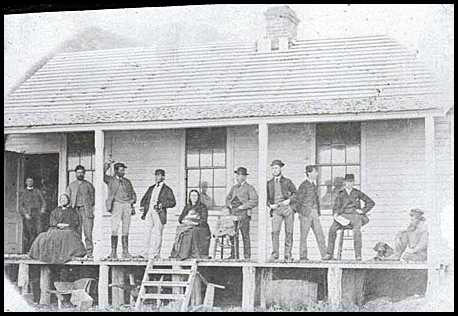The Australia - New Zealand cable: 1876.
- Australia 1901-1988
- New South Wales
- Queensland
- South Australia
- Tasmania
- Victoria
- Western Australia
- International
- Special aspects
The beginnings of the telegraph in New Zealand.
The first official Post Office in New Zealand was opened in 1840 by Captain Hopson who was the Lieutenant Governor. William Hayes was appointed as the Postmaster - but unfortunately became the first Civil Officer to be removed from his post only six months later. He was charged with neglect of duty, dishonesty and continual inebriety.
In 1862, the first telegraph line in New Zealand was opened. It ran between Lyttleton and Christchurch. This selection was made partly because of the gold discoveries in the South Island bringing increased business. Seven other telegraph offices were soon established - all on the South Island. A line was run from Christchurch to Dunedin with Port Chalmers linked to Dunedin soon after. A map is shown elsewhere. By 1863, there were nine independent telegraph networks covering much of the South Island. It was difficult to construct telegraph lines on the North Island because of the aggression of the Maoris there.
| On 26 August 1865, a cable linking the two main islands was successfully laid between Lyall Bay in Wellington and White’s Bay (Marlborough) on the east coast on the second attempt. The first telegraph office could then be opened on the North Island. Offices linked to the cable connection were opened at Picton in 1865 with additional offices at Blenheim and Nelson in 1866.
In 1873, the station, equipment and personnel were moved from White's Bay to Blenheim because of the harsh conditions at White's Bay.
|
 White's Bay Cable Station 1866. Source: Malborough Museum. |
In 1872, a telegraph line linking Auckland with Christchurch was completed.
In 1875, the line was extended from Nelson to Westport. Subsequently, local lines in New Zealand became numerous with every place of the slightest importance in either the north or the south islands being placed in communication with the seat of Government.
The Electric Telegraphs Department, having been established in 1863 in an attempt to place the nine independent telegraph networks under a central control, was merged with the Post Office Department in 1881. This merger was an attempt to thwart the Electric Telegraph Company of Chicago - the forunner of Ameritech and Bell Atlantic - from opening an exchange in New Zealand.
The Adelaide Evening Journal of 18 July 1870 commented on three important issues with relevance to Australian Telegraphy also:
TELEGRAPH CHARGES AND ORGANIZATIONS.
Not long ago the General Government of New Zealand very greatly reduced the rates on telegrams with the following results:
- during March, the last month of the old system, the number of ordinary telegrams had been 8,407, producing £1,356 8s.;
- in April, the first month of the new tariff, the aggregate of messages was 13,722, yielding £1,210 15s. 6d.
Thus, though the revenue, owing to the thoroughness of the reduction in prices, suffered to the extent of £145 12s. 6d., no less than 5,315 extra telegrams were sent. Writing on the subject, the leading Dunedin paper says too "there can be no doubt that the Department will soon recover the slight loss sustained during the first month, which was, at least in part, caused by the short notice given regarding the reduction of the rates.
But the Government did not stop here. A system of telegraphic money orders has been established, by which Postmasters at any money order office will be enabled to grant orders by telegraph upon any other money order office in the colony for any sum not exceeding £10. This system only came into operation on the 15th instant, and has consequently not yet been fairly tested.
We further understand that the Commissioner of Telegraphs proposes to arrange with the Australian Governments for the despatch of stamped telegraphic messages by the steamers to New Zealand, in much the same way as the ordinary mails are now made up. By this means all telegrams addressed 'Telegraphist, New Zealand', would be at once conveyed to the nearest Telegraph Office on the arrival of the steamer at a New Zealand port and transmitted to the persons to whom they may be addressed.
Finally, it will be seen from the Governor's address at the opening of the General Assembly, that it is proposed to connect New Zealand with Australia by means of a submarine cable".